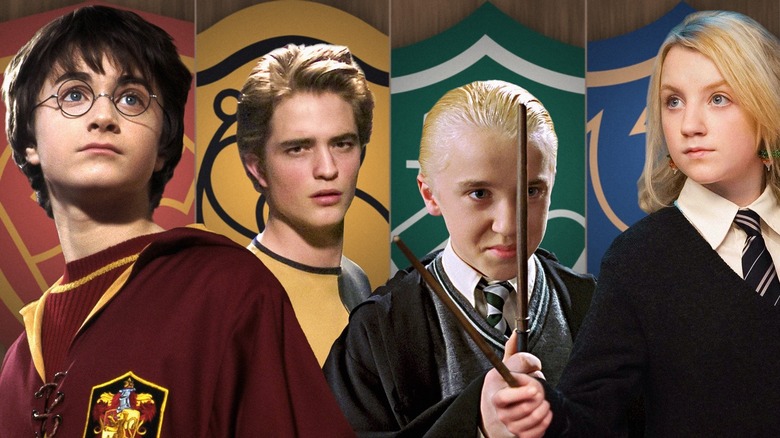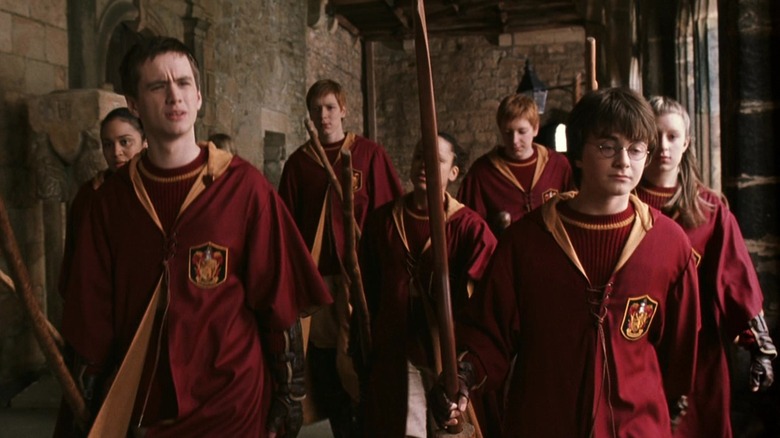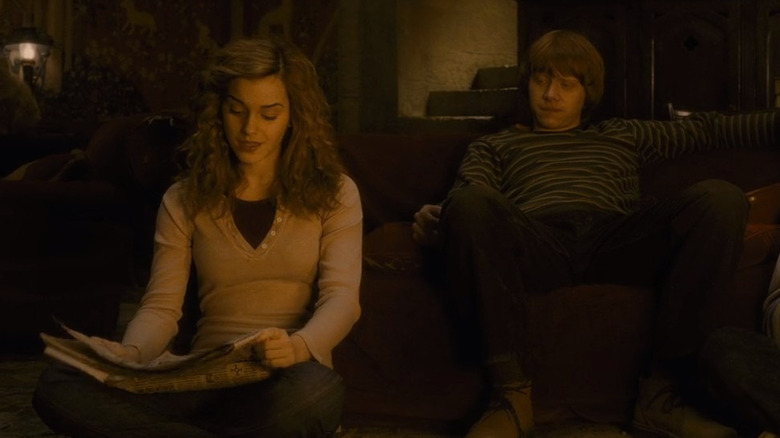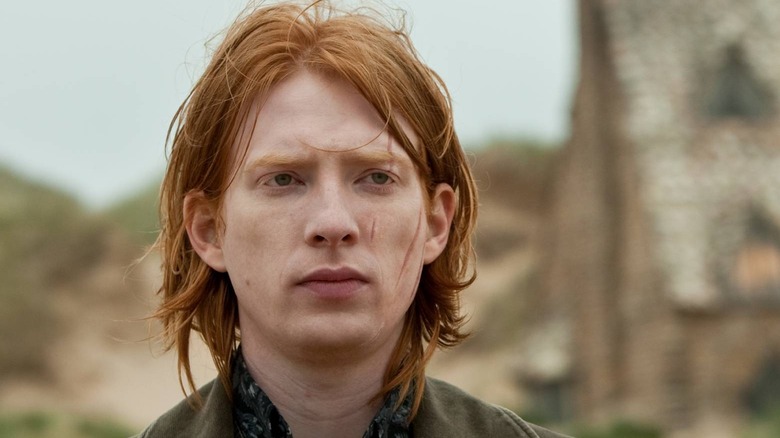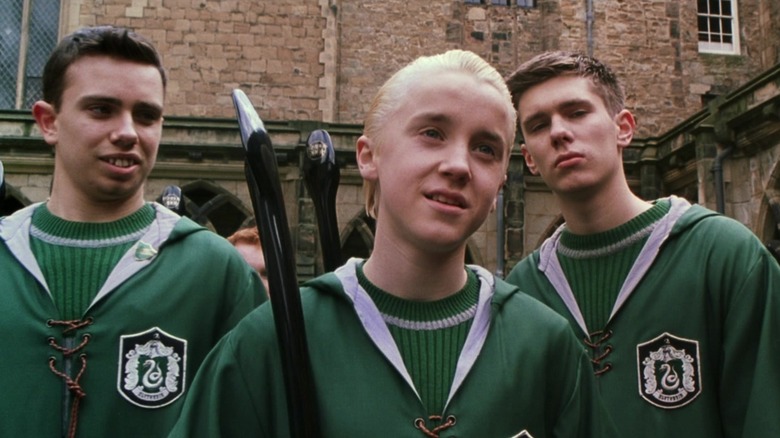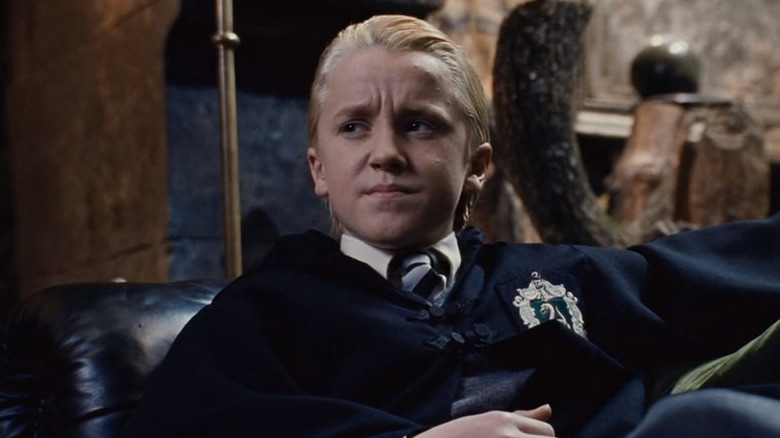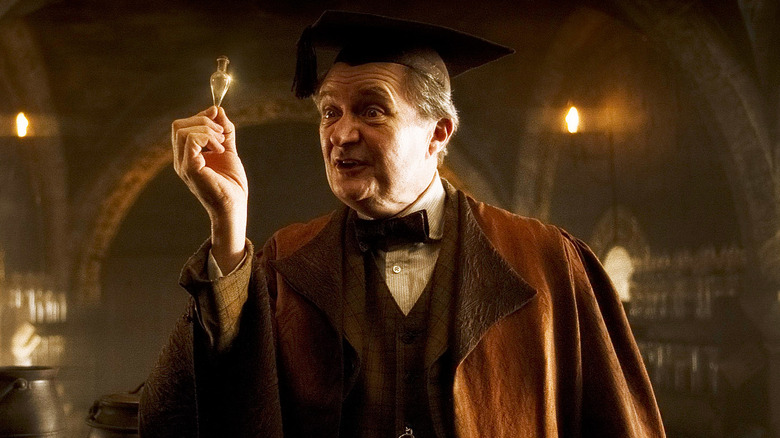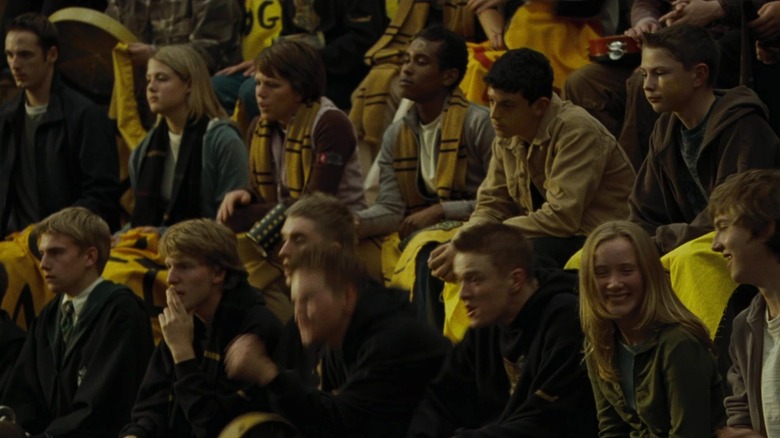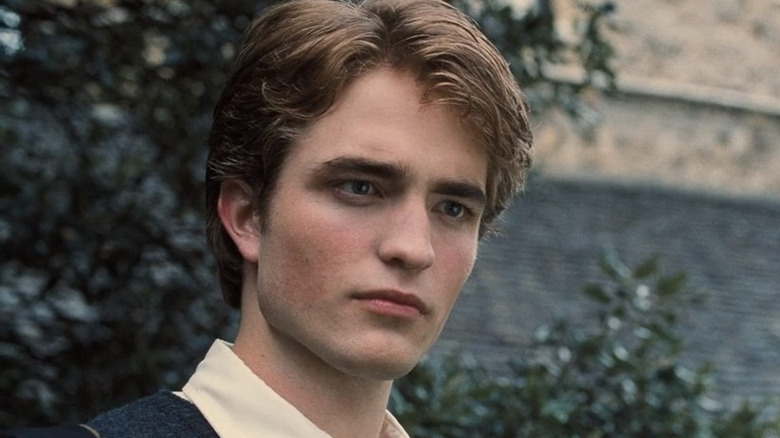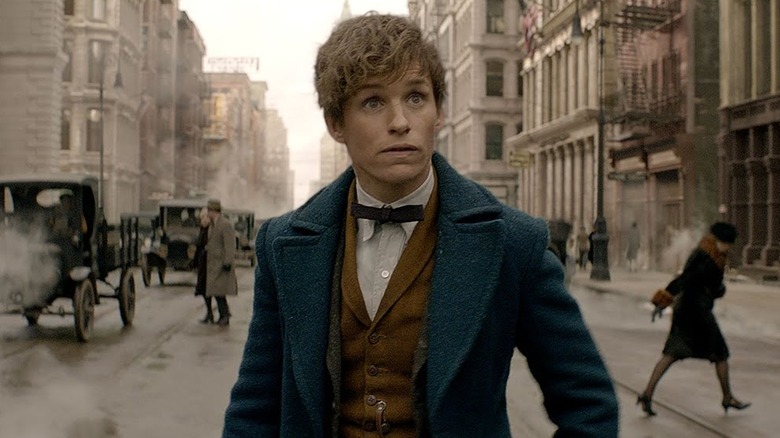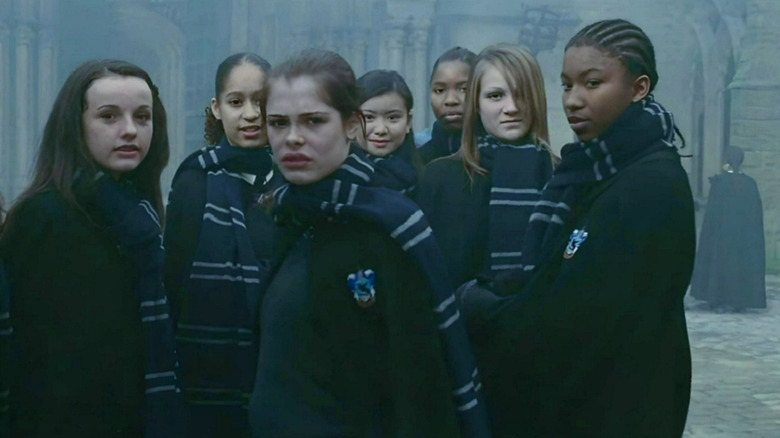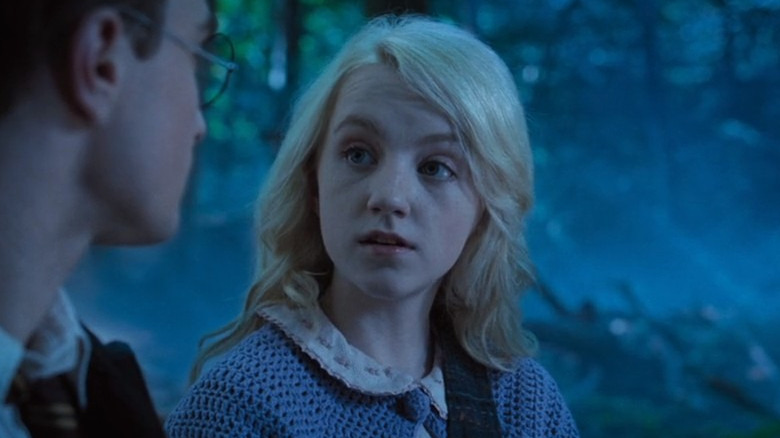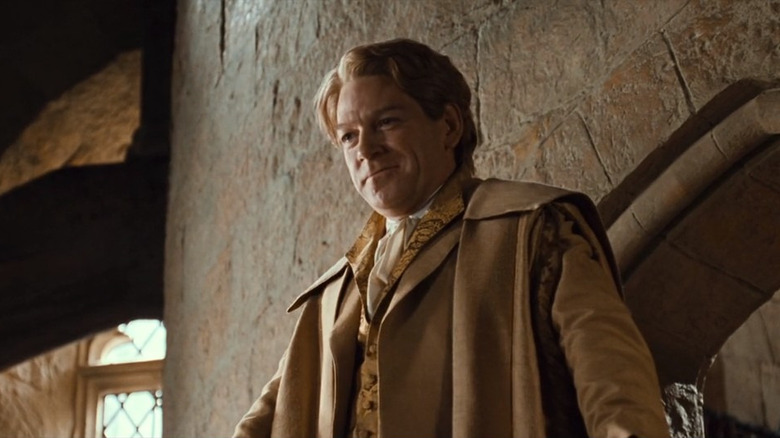Harry Potter: Every Hogwarts House Explained
The "Harry Potter" franchise created an entire generation of children who dreamed of attending Hogwarts. Fans of the series take online sorting quizzes and choose their Houses, identifying with different characteristics and students within each one. "Harry Potter" parties typically include a sorting method, sometimes using the iconic Sorting Hat, to place guests in a House, even if it's just for the event.
The four houses each represent a different type of student that attends Hogwarts and the different ideals of the four Hogwarts founders. Some houses are more popular than others, and some have better reputations, but the houses give every student at the wizarding school a home away from home and a group of people that are similar to them.
If you want to know more about the Hogwarts houses and the famous witches and wizards in each one, we've put together everything you need to know about Gryffindor, Slytherin, Hufflepuff, and Ravenclaw. While this article won't help you sort yourself into a Hogwarts house, it gives you exactly what you need to know before you put on the Sorting Hat.
Gryffindor
Even if you aren't familiar with "Harry Potter," chances are you have heard the word "Gryffindor" before. Gryffindor is the home of Harry, Ron, and Hermione and receives the most attention in the books and films. The house is home to the bravest, most courageous, and most determined students at Hogwarts.
The house colors are gold and scarlet red, and the house mascot is the lion. Red is considered a "bold color," one that is associated with determination, just like Gryffindor students. Gryffindors certainly make bold decisions, like when Harry doesn't hesitate to save the other students during the Second Task of the Triwizard Tournament in "Harry Potter and the Goblet of Fire" or when he forms the secret society Dumbledore's Army to help ready others for the impending war in "Harry Potter and the Order of the Phoenix." This color symbolism is also represented in the rubies of the house hourglass that counts house points. Historically, lions are linked with courage and valor, which line up with Gryffindors perfectly.
Every Hogwarts house has a ghost. House ghosts are typically former students who choose to become ghosts upon their deaths and return to Hogwarts to help serve future students. The Gryffindor house ghost is Sir Nicholas de Mimsy-Porpington, also known to students as Nearly Headless Nick. He was executed in 1492, though his beheading wasn't completely successful because his head was still attached to his body by a half-inch flap of skin.
The life of a Gryffindor student
Gryffindor students live in Gryffindor Tower, located on the seventh floor of the castle. They enter the tower by giving a password to the Fat Lady, a portrait. The common room is a circular room with a fireplace, tables, and large armchairs and sofas. Two staircases lead to the boys and girls dormitories, though if a boy tries to climb the stairs to the girls' rooms the entire staircase will turn into a slide.
In the series, students play popular wizarding games like Exploding Snap and Wizard Chess in the common room to pass the time. Fred and George Weasley used the space to conduct experiments with their magical sweets, though Hermione discouraged them. Students also host parties to celebrate Quidditch victories and use the area to study and work on homework together.
A part of being a Gryffindor student is participating in the rivalry against Slytherin. Throughout the series, students in each house egg each other on as they toss insults back and forth on a regular basis and use the Quidditch pitch and house point competition to prove their superiority over the other. This rivalry was only intensified by the classes the two houses shared. When Harry is at Hogwarts, Gryffindor and Slytherin students take Potions together, which was often taught by the Slytherin Head of House, giving Slytherin students the confidence to make derogatory remarks.
Notable Gryffindor alumni
Fans are familiar with popular Gryffindors like Harry, Ron, and Hermione, but there are several other notable alumni who were members of the house during their time at Hogwarts. From wizarding popular culture, Celestina Warbeck, the famous wizarding singer known for her song "A Cauldron Full Of Hot, Strong Love," is a Gryffindor.
All of the Weasley siblings, including Bill and Charlie, were sorted into Gryffindor. Bill went on to become a curse-breaker for the wizarding bank Gringotts. While he was a student, he served as a Prefect and Head Boy and earned 12 Outstanding marks on his O.W.L. exams.
Charlie Weasley was remembered for his Quidditch abilities, playing as Gryffindor's seeker. Though some students felt he could have played Quidditch professionally if he wanted, he instead chose to work with dragons. It's strongly suspected by the fan base, based on what is implied within the series, that Charlie left Hogwarts during his sixth year to move to Romania to begin his career at a dragon sanctuary.
One of the most well-known Gryffindor alumni is Albus Dumbledore. The wizard not only played a significant role in both wizarding wars, but he also discovered the 12 uses of dragon blood, created the Order of the Phoenix, and won numerous awards over the course of his life, like being granted the Order of Merlin, First Class. He also served as chief warlock for the Wizengamot and supreme mugwump for the International Confederation of Wizards.
Slytherin
Slytherin is often considered the "evil" house of Hogwarts, but there is much more to the house founded by Salazar Slytherin. Slytherins are known for their cunning and ambition, which is part of why Slytherin students get a bad rap. These traits, combined with the founder's preference for pure-blooded students, creates a negative image of the house.
Slytherin's colors are green and silver, and its mascot is a snake or serpent. Green is often considered a calming or peaceful color, but it is also one of envy and pride. It represents how Slytherins can use their ambition and cunning for both good and evil. Snakes are commonly associated with rebirth due to the shedding of their skin, but when their biblical depiction is considered, they also share the house traits. In the story of Adam and Eve, the snake uses deceit to convince the two to eat from the Tree of Life. The aspect of rebirth can be applied to several Slytherins, like Malfoy, who originally fell in with the "evil" members and alumni of the house before turning towards the "light" as adults.
The house ghost is the Bloody Baron. In life, he was in love with the Ravenclaw founder's daughter. When she ran away, he went after her at her mother's request. However, when he was unsuccessful in convincing her to come home, he killed her and then took his own life.
The life of a Slytherin student
The Slytherin dormitories are in the dungeons. Students have to stand in front of the correct spot on a blank wall and provide the correct password. The interior of the common room includes leather sofas, armchairs, and green lamps. Part of what adds to the ambiance of the space is the green lighting that it has, which comes from being underneath the Great Lake. Students can see fish and other creatures swim by through the windows.
During Harry's time at Hogwarts, Slytherin students took Potions and Care of Magical Creatures classes with Gryffindor students. After O.W.L. exams, their classes would consist of students from every house. When Slytherin students aren't in classes, they are likely spending time in their common room and around the grounds of Hogwarts. During Harry's time at Hogwarts, he regularly ran into Draco and other Slytherins outside of class around campus, from the Quidditch pitch to school courtyards. If allowed, they make trips to Hogsmeade starting in their third year.
Slytherin students have a longstanding rivalry with Gryffindor. This comes out during Harry's time at Hogwarts, particularly between Draco Malfoy and Harry, and between the house Quidditch teams.
Notable Slytherin alumni
While many know that Lord Voldemort was a Slytherin, there are several other house alumni who didn't go down the same path. One of the most well-known wizards of all time, Merlin, was a Slytherin, and he did not cause a wizarding war like Voldemort did.
Horace Slughorn, a long-time Hogwarts Potions professor, was sorted into Slytherin during his time as a student. Slughorn isn't just known for his potions abilities; he is also known for his collection of people. Slughorn enjoyed having connections to famous individuals, including people within the Ministry of Magic and popular Quidditch players.
Previous Hogwarts Headmaster Phineas Nigellus Black was also a Slytherin, as were many members of the Black family. Like other previous headmasters, Black's portrait hung in the headmaster's office at Hogwarts, meaning Harry and other students interacted with the portrait. Though little is known about him during his life, in death as a portrait he did favors for the headmasters that came after him, including helping Severus Snape check on Harry, Ron, and Hermione in "Harry Potter and the Deathly Hallows."
Hufflepuff
Hufflepuffs don't value any particular trait over another. Instead, founder Helga Hufflepuff focused on students who are loyal and kind hard workers. This led to the thought that the house simply takes the students other houses aren't interested in, which isn't the case.
The Hufflepuff house colors are black and yellow, and its mascot is the badger. Yellow is a bright color, associated with someone full of energy. It is also a color that tends to pair well with others, just like how Hufflepuffs get along well with everyone because of their patience and kindness. It may seem like having black as a second color contradicts that, but it can also be used to show strength. One of the attributes of the house is its fairness, and it takes great strength to remain fair and just in every situation. This strength is mirrored in the diamonds used in their house hourglass, as diamonds are one of the hardest materials, as well as in their mascot.
The Fat Friar is the Hufflepuff house ghost. He is the happiest of the house ghosts, known for wishing first years good luck before the sorting ceremony. Like Nearly Headless Nick, he was executed. He was suspected of witchcraft because he could cure pox spots. As a clergyman, his untimely death meant he never became a cardinal, which is something he was unhappy about.
The life of a Hufflepuff student
The Hufflepuff dormitories can be found by the Hogwarts kitchens, which are located directly beneath the Great Hall. To enter, students must tap a certain barrel within a stack of barrels to the rhythm of their house founder's name. If students tap the wrong pattern or use the wrong barrel, they will be covered in vinegar. The common room is filled with plants, and a portrait of Helga Hufflepuff sits above a mantel. Many of the windows are round, and the doors to get to the dorms are also round.
Hufflepuff students took Herbology with Gryffindors during Harry's time at Hogwarts. After O.W.L. exams, they took courses with students from every house. Like other houses, it's likely that when students aren't in their common room, they are exploring the Hogwarts grounds, going to Quidditch matches, or visiting Hogsmeade. During Harry's second year at Hogwarts, he overhears a group of Hufflepuff students studying together in the library.
Notable Hufflepuff alumni
The "Fantastic Beasts" trilogy introduced audiences to arguably one of the most well-known and popular Hufflepuff alumni: Newt Scamander. While the magizoologist was almost expelled from Hogwarts after an incident with a Jarvey, he went on to become one of the world's leading magical creature experts. When he wasn't writing the important text "Fantastic Beasts and Where to Find Them," he was helping Albus Dumbledore with the war effort and assisting the then-Hogwarts professor in his quest to stop Gellert Grindelwald. His brother, Theseus, who also helped in the war effort and was an auror for the Ministry of Magic, was also a Hufflepuff student.
Another notable house alumnus is Grogan Stump. He served as Minister of Magic from 1811 to 1819. He is credited as the individual who established the Department of Magical Games and Sports, which oversees important sporting events like the Quidditch World Cup, and developed the definitions still used to classify creatures as beasts, beings, or spirits. Before those definitions existed, it was hotly debated where certain creatures would fall, particularly centaurs and goblins, as previous definitions used a creature's intelligence to determine how to categorize them.
Ravenclaw
Ravenclaw, founded by Rowena Ravenclaw, focuses on students interested in learning and wisdom. While most students at Hogwarts are there to learn, Ravenclaws take their quest for knowledge to a new level with their diligence.
The house colors from the books are blue and bronze, and their mascot is the eagle. Blue isn't a color that only evokes sadness; it also can symbolize confidence and obsession, which describes how Ravenclaw students are when they are studying or trying to find new information. Sadness is represented in their house ghost, the Grey Lady. The only house ghost related to a founder, the Grey Lady, also known as Helena Ravenclaw, died after she stole her mother's diadem and refused to go back to Hogwarts when a baron came for her. In love with her, the baron killed her when she wouldn't follow him.
In heraldry, the eagle has long symbolized glory, power, and conquest, but the bird's eyesight is also associated with truth and clarity. This is the perfect mascot for scholarly students who use their wit and knowledge to make decisions.
Audiences may notice that Ravenclaw's colors in the film adaptations are blue and silver. Their mascot is also changed from an eagle to a raven — possibly because it's more intuitive to have a raven as the Ravenclaw symbol, but the raven also symbolizes intelligence, wisdom, solitude, and spirituality, which are traits that may better represent Ravenclaw students. While there has never been an explicit reason given as to why the color and mascot were only changed for Ravenclaw, the fandom has speculated that this change was an aesthetic one, that blue and silver looked better on screen than blue and bronze.
The life of a Ravenclaw student
The Ravenclaw dormitories are located in Ravenclaw Tower on the fifth floor of the castle. Before students can enter, they must answer a riddle or question from the bronze eagle knocker. If they get it correct or provide a strong enough answer, the door to the common room will swing open. If they can't provide an answer, students are forced to wait until someone does.
The common room is filled with tables and bookshelves, creating an ideal study environment for Ravenclaw students. With a house library at their fingertips, students could remain in their dorm rather than venture to the library. In celebration of their founder, a marble statue of Rowena Ravenclaw stands beside the door to the dorm rooms. She wears her diadem in the depiction.
Like other houses, Ravenclaw has a Quidditch team, and students can explore the grounds and Hogsmeade. Ravenclaws and Hufflepuffs were members of the Order of the Phoenix during Harry's fifth year. Luna Lovegood, a Ravenclaw student one year below Harry, even went with Harry to the Ministry of Magic during "Harry Potter and the Order of the Phoenix."
Notable Ravenclaw alumni
Fans are familiar with Luna Lovegood and Cho Chang, two popular Ravenclaws in the series, but they may not know some of these house members. Uric the Oddball is one of the most interesting historical figures of the wizarding world because of the odd circumstances he put himself in. He lived during the Middle Ages and regularly pushed boundaries. Uric listened to a Fwooper, an African bird that can drive someone unwell in the head with their call, for three months in the name of health benefits and slept in a room with Augureys, thinking their cries meant he was dead. He is included in the History of Magic curriculum at Hogwarts for his escapades.
Another important historical figure who called Ravenclaw home during their education was Ignatia Wildsmith. The witch attended Hogwarts during the 13th century before going on to invent one of the most important forms of wizarding transportation: Floo Powder.
Famous generational wandmaker Garrick Ollivander was also a Ravenclaw student during his time at Hogwarts, as was Gilderoy Lockhart, a short-lived Defense Against the Dark Arts professor, author, and a five-time winner of the Witch Weekly Most Charming Smile Award.
